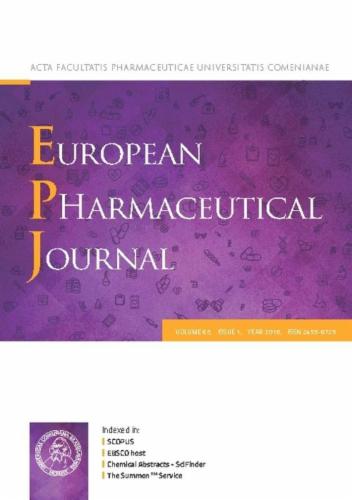3D打印纳米复合水凝胶中表面修饰介孔二氧化硅纳米颗粒的功能酶递送。
IF 4.3
3区 医学
Q1 PHARMACOLOGY & PHARMACY
引用次数: 0
摘要
三维(3D)打印的基于水凝胶的支架已经成为生物制剂输送的有前途的材料。最近,我们开发了一种可打印的植物基纳米复合水凝胶,由阴离子纤维素纳米纤维(T-CNF)和甲基丙烯酸半乳糖葡甘露聚糖(GGMMA)组成,并用不同表面电荷的介孔二氧化硅纳米颗粒(MSNs)增强。然而,确保所递送的生物分子的生物活性需要进一步的研究来验证所开发的生物材料的功能。为此,本研究选择辣根过氧化物酶(HRP)和溶菌酶作为不同的模型蛋白,在MSN固定化和3D打印后评估它们的固定化稳定性和生物活性。利用多参数表面等离子体共振(MP-SPR)和分子动力学(MD)模拟研究了酶与不同表面修饰的msn之间的相互作用。我们观察到,MSN表面电荷是酶的吸附程度和活性控制的关键。带正电荷的msn表现出最高的HRP固定化程度,但两种酶的活性都显著降低。相比之下,接近中性和带负电荷的msn分别为HRP和溶菌酶提供了更好的稳定性和活性保持。除了溶菌酶/水凝胶外,HRP/水凝胶和载酶的纳米复合水凝胶(载酶的近中性和载溶菌酶的负电荷msn)在不同的UV后固化时间下成功3D打印。虽然负载酶的纳米复合材料支架具有良好的固定化稳定性,但光引发剂的存在会导致两种酶的失活。无论采用何种交联方法,该基质作为各种生物分子的递送载体显示出巨大的潜力,在组织工程和伤口愈合方面具有广阔的应用前景。本文章由计算机程序翻译,如有差异,请以英文原文为准。
Functional enzyme delivery via surface-modified mesoporous silica nanoparticles in 3D printed nanocomposite hydrogels
Three-dimensional (3D) printed hydrogel-based scaffolds have emerged as promising for the delivery of biologicals. Recently, we developed a printable plant-based nanocomposite hydrogel, composed of anionic cellulose nanofibers (T-CNF) and methacrylated galactoglucomannan (GGMMA), reinforced with mesoporous silica nanoparticles (MSNs) of different surface charges. However, ensuring the biological activity of the delivered biomolecules requires further investigation to validate the functionality of the developed biomaterial. To investigate this, in this study, horseradish peroxidase (HRP) and lysozyme were selected as distinct model proteins, assessing their immobilization stability and biological activity after MSN immobilization and 3D printing. The interactions between the enzymes and differently surface-modified MSNs were explored using multi-parametric surface plasmon resonance (MP-SPR) and molecular dynamics (MD) simulations. We observed that MSN surface charge is key to the extent of enzyme adsorption and activity control. Positively charged MSNs showed the highest HRP immobilization but caused significant activity loss in both enzymes. In contrast, near-neutral and negatively charged MSNs provided improved stability and activity retention for HRP and lysozyme, respectively. Except for lysozyme/hydrogel, HRP/hydrogel and enzyme-loaded nanocomposite hydrogels (HRP-loaded near-neutral and lysozyme-loaded negatively charged MSNs) were successfully 3D printed using different UV post-curing times. While enzyme-laden nanocomposite scaffolds showed promising immobilization stability, the presence of the photoinitiator caused significant inactivation for both enzymes. Irrespective of the crosslinking approach, this matrix demonstrates significant potential as a delivery carrier for various biomolecules, with promising applications in tissue engineering and wound healing.
求助全文
通过发布文献求助,成功后即可免费获取论文全文。
去求助
来源期刊
CiteScore
9.60
自引率
2.20%
发文量
248
审稿时长
50 days
期刊介绍:
The journal publishes research articles, review articles and scientific commentaries on all aspects of the pharmaceutical sciences with emphasis on conceptual novelty and scientific quality. The Editors welcome articles in this multidisciplinary field, with a focus on topics relevant for drug discovery and development.
More specifically, the Journal publishes reports on medicinal chemistry, pharmacology, drug absorption and metabolism, pharmacokinetics and pharmacodynamics, pharmaceutical and biomedical analysis, drug delivery (including gene delivery), drug targeting, pharmaceutical technology, pharmaceutical biotechnology and clinical drug evaluation. The journal will typically not give priority to manuscripts focusing primarily on organic synthesis, natural products, adaptation of analytical approaches, or discussions pertaining to drug policy making.
Scientific commentaries and review articles are generally by invitation only or by consent of the Editors. Proceedings of scientific meetings may be published as special issues or supplements to the Journal.

 求助内容:
求助内容: 应助结果提醒方式:
应助结果提醒方式:


